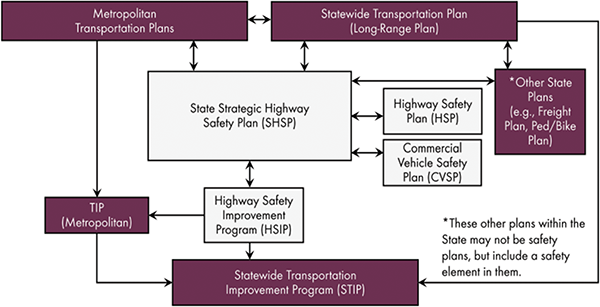The Delaware practice is discussed after the following introduction about SHSP integration.
Other states in this SHSP Integration Noteworthy Practices series: ID, ME, MD, ND, WA
Introduction to SHSP Integration
The Strategic Highway Safety Plan (SHSP) is a statewide-coordinated safety plan that provides a comprehensive framework for reducing the number of deaths and serious injuries on all public roads. In each State, the SHSP identifies the State's safety goals, objectives and key emphasis areas. It is intended to serve as an ‘umbrella’ plan that is integrated into other State transportation plans and guides the State's roadway safety investment decisions.
Integration Defined
Integration is the act of bringing together or incorporating various parts into a whole. Integration is relevant and important to a State's planning process because every State has numerous transportation plans; each one potentially addressing safety in a different way. The SHSP is the mechanism to bring these safety “parts” together to form a consistent and “whole” safety program for the State.
The Purpose and Benefits of Integration
The purpose of integration is to coordinate and focus the State's roadway safety efforts to maximize the State's ability to save lives.
Through integration, the safety needs of the State can be addressed more strategically and resources can be shared more effectively. As illustrated in Figure 1, integration encourages State partners to strive toward common goals, collectively implement appropriate strategies and actions, share resources to meet or exceed the State's goals and objectives, and most importantly to save lives.

Other potential integration benefits include:
- The use of consistent data and analysis methods.
- Improved allocation of resources to more effectively produce safety improvements.
- Improvements to safety culture across State, regional, and local agencies.
- A reduction in the administrative burden on States and local agencies.
Integration of Plans and Processes
State transportation plans and programs that the SHSP should be integrated with include the Statewide Long Range Transportation Plan (LRTP), Statewide Transportation Improvement Plan (STIP), State Highway Safety Improvement Programs (HSIPs), the Commercial Vehicle Safety Plan (CVSP), the Highway Safety Plan (HSP) Metropolitan Transportation Plans (TIPs), and various modal and regional transportation plans. The relationship of these plans is illustrated in Figure 2.

An integrated SHSP positions the State DOT and its safety partners to collectively address the State's safety challenges on all public roads through coordination and consistency among with the following State and regional plans and programs:
- LRTPs to promote a long-range vision that incorporates safety priorities.
- HSIP projects to be consistent with the SHSP emphasis areas and strategies.
- STIPS/TIPS to align programming of projects with SHSP strategies and countermeasures.
- CVSPs to facilitate exchange and collaboration between the commercial motor vehicle safety community and the broader safety community.
- HSPs to ensure a consistent, data-driven approach to improving highway safety, especially in SHSP emphasis areas.
In addition, the SHSP should integrate with city and county planning processes to ensure consideration of safety concerns on all road types.
SHSP Integration Indicators
Indicators that the SHSP and other transportation plans and processes are integrated include the following:
- Other transportation plans incorporate elements of the SHSP and include consistent and supporting safety goals, performance measures, objectives, and strategies.
- The priorities and goals of other transportation programs and plans are considered when developing the SHSP.
- Safety partners have access to and use of common safety data, analysis, and methods for determining safety priorities.
- The SHSP is developed with sustained input from disciplines and agencies representing the 4Es of safety (engineering, enforcement, education, and emergency medical services).
- Safety partners assist in the implementation of SHSP strategies.
- SHSP stakeholders and experts are included in other transportation planning processes.
- SHSP priorities and strategies are considered in project prioritization and programming.
- Various sources of funding are used to achieve safety goals.
- Progress towards safety goals is measured jointly and regularly.
Delaware
Background
A core committee of coordinating agencies made up of Delaware Department of Transportation (DelDOT), Delaware's Office of Highway Safety (OHS), the Delaware State Police (DSP), the Delaware Office of Emergency Medical Services (OEMS), and the Delaware Department of Justice led the update of the Delaware Strategic Highway Safety Plan in 2010. The committee closely coordinated with the Federal Highway Administration (FHWA) and the National Highway Traffic Safety Administration (NHTSA) throughout the process.
SHSP Integration Practices
Collaborative SHSP Development and Implementation
The process of developing Delaware's 2010 SHSP update helped to strengthen existing partnerships across safety agencies in Delaware. Including all of the key State public safety agencies on the core committee responsible for updating the SHSP ensured that all of the agencies had a chance to review the same crash data, reach agreement about safety priorities in the State based on the crash data, and identify a robust set of multidisciplinary strategies to address each crash type. The inclusion of the OEMS on the core committee led to the identification of a number of new emergency response strategies being included in the 2010 update. The core coordinating agencies continue to work together on various safety initiatives and coordinate to ensure that the strategies identified in the SHSP are implemented. DelDOT also uses the SHSP as an outreach tool for talking to other public agencies within Delaware about the State's roadway safety priorities and strategies.
Coordinated Goals
The coordinating agencies reviewed fatal crash data as well as FHWA and American Association of State Highway and Transportation Officials (AASHTO) guidelines for SHSPs to select and prioritize the emphasis areas in accordance with the frequency of the associated crash type. In addition to emphasis areas based on crash types, the coordinating agencies added “Improving Traffic Records” as an emphasis area.
Although the national and statewide overall SHSP goals are based on fatality rates rather than fatal crash rates, Delaware's coordinating agencies agreed to base Delaware's data analyses and performance-based goals for each emphasis area on the number of fatal crashes rather than the number of fatalities for all data-driven emphasis areas, except for the emphasis area dedicated to Increasing Seat Belt Usage.
The SHSP established goals for each primary emphasis area based on a percent reduction in the number of fatal crashes and the corresponding reduction in the number of fatal crashes. Additionally, the group reviewed the goals in other Delaware safety plans including OHS's FY 2010 Highway Safety Plan (HSP), the Delaware Traffic Safety Information System Strategic Plan, and DSP's FY 2010 Motor Carrier Safety Assistance Program Commercial Vehicle Safety Plan (CVSP), to ensure that the goals of the SHSP were consistent with the goals of other statewide initiatives.
SHSP Strategies Reflected as Projects in Highway Safety Plan
The coordinating agencies selected education, enforcement, engineering, and emergency services strategies to address each emphasis area. Strategies were selected based on their cost-effectiveness, potential rate of return, and proven effectiveness.
SHSP strategies are reflected in other State plans, such as the HSP. For example, an SHSP emphasis area is “Increasing Seat Belt Usage.” The strategies in the SHSP involve educational and enforcement campaigns to inform the public of the safety benefits of wearing a seat belt. Enforcement and education strategies are reflected in Delaware's most recent HSP, as projects to provide funding to law enforcement agencies with an identified traffic safety problem to conduct enforcement blitzes focused on occupant protection violations. The enforcement includes both checkpoints and saturation patrols and is supported by paid media.
Coordination among the agencies has been particularly important for establishing and implementing strategies for “Improving Traffic Records.” The State Traffic Records Coordinating Committee (TRCC) is responsible for leading data improvement efforts in Delaware. The TRCC's Traffic Safety Information System Strategic Plan is referenced in the SHSP as well as the HSP as the guide to ensure that the proper steps are being taken to create data systems that are timely, accurate, consistent, complete, and accessible.
The SHSP outlines the projects and strategies to improve information and decision support systems that are in the TRCC's Strategic Plan, such as expansion of the Crash Analysis Reporting System (CARS) to support DelDOT's safety program, and a new EMS data system (Delaware Information Management for Emergency Services (DIMES). The HSP then specifies traffic records projects and the allocation of funds to activities such as:
- E-crash enhancements
- CARS enhancements
- DIMES system for the Office Emergency Medical Services
Data projects like these have been instrumental in advancing Delaware's ability to utilize comprehensive traffic safety data when making resource allocation decisions.
Key Accomplishments
- Committee of coordinating agencies instrumental in developing and implementing plan
- Aligned goals and strategies in the SHSP, HSP and CVSP
- Identified emergency services strategies to address each primary emphasis area
- Identified roles and responsibilities for leading 4E strategies
- Strengthened partnerships among State safety agencies
See these other SHSP Integration Noteworthy Practices:
Contact
Adam Weiser
Delaware Department of Transportation
(302) 659-4073
Adam.Weiser@state.de.us
